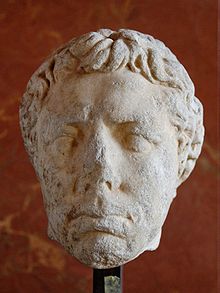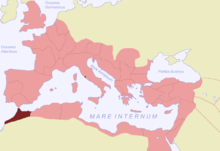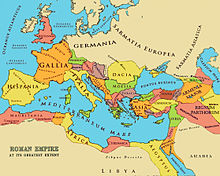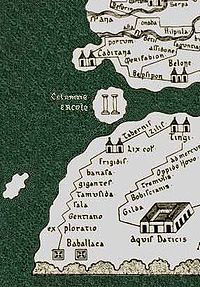- Mauretania
-
For the sailing vessel, see RMS Mauretania (disambiguation). For the modern country, see Mauritania.
Kingdom of Mauretania ← 
110 BC–40  →
→Capital Not specified Language(s) Berber Government Monarchy King - 110-80 BC Bocchus I - 23-40 AD Ptolemy of Mauretania Historical era Classical Antiquity - Established 110 BC - Client state of the Roman Empire 33 BC - Became Roman Province 40 Mauretania is a part of the historical Ancient Libyan land in North Africa. It corresponds to present day Morocco and a part of western Algeria. Mauretania in antiquity was the western neighbour of the ancient kingdom of Numidia.
Contents
History
In antiquity, Mauretania was originally an independent kingdom on the Mediterranean coast of north Africa (named after the Mauri tribe, after whom the Moors were named), corresponding to northern Morocco. Some of its earliest recorded history relates to Phoenician and Carthaginian settlements such as Lixus, Volubilis, Mogador and Chellah.[1] The kingdom of Mauretania was not situated on the Atlantic coast south of Western Sahara, where modern Mauritania lies.
Roman Mauretania
After the defeat of Carthage by the Roman Empire Mauretania became a Roman client kingdom.[2] The Romans placed Juba II of Numidia as their client-king. When Juba died in 23 AD, his Roman-educated son Ptolemy of Mauretania succeeded him on the throne. Caligula killed Ptolemy in 40. Claudius annexed Mauretania directly as a Roman province in 44, under an imperial (not senatorial) governor.
Not depriving the Mauri of their line of kings would have contributed to preserving loyalty and order, it appears: "The Mauri, indeed, manifestly worship kings, and do not conceal their name by any disguise," Cyprian observed in 247, likely quoting a geographer rather than personal observation, in his brief euhemerist exercise in deflating the gods entitled On the Vanity of Idols.[3]
In the first century Emperor Claudius divided the Roman province of Mauretania into Mauretania Caesariensis and Mauretania Tingitana along the line of the Mulucha (Muluya) River, about 60 km west of modern Oran:
- Mauretania Tingitana, named after its capital Tingis (now Tangier); it corresponded to northern Morocco including the Spanish enclaves.
- Mauretania Caesariensis, comprising western and central Algeria as far as Kabylia.
Mauretania gave to the empire one emperor, the equestrian Macrinus, who seized power after the assassination of Caracalla in 217 but was himself defeated and executed by Elagabalus the next year.
Since emperor Diocletian's Tetrarchy reform (293), the country was further divided in three provinces, as the small, easternmost region Sitifensis was split off from Mauretania Caesariensis.
The Notitia Dignitatum (circa 400) mentions them still, two being under the authority of the Vicarius of the diocese of Africa:
- a Dux et praeses provinciae Mauritaniae et Caesariensis, i.e., a Roman governor of the rank of Vir spectabilis, who also holds the high military command of 'duke', as the superior of eight border garrison commanders, each styled Praepositus limitis, named (genitive forms) Columnatensis, Vidensis, Praepositus limitis inferioris (i.e., lower border), Fortensis, Muticitani, Audiensis, Caputcellensis and Augustensis.
- an (ordinary, civilian) Praeses in the province of Mauretania Sitifensis.
And, under the authority of the Vicarius of the diocese of Hispaniae:
- a Comes rei militaris of (Mauretania -, but not mentioning that part of the name) Tingitana, also ranking as vir spectabilis, in charge of the following border garrison (Limitanei) commanders: Praefectus alae Herculeae at Tamuco, Tribunus cohortis secundae Hispanorum at Duga, Tribunus cohortis primae Herculeae at Aulucos, Tribunus cohortis primae Ityraeorum at Castrabarensis, another Tribunus cohortis at Sala, Tribunus cohortis Pacatianensis at Pacatiana, Tribunus cohortis tertiae Asturum at Tabernas and Tribunus cohortis Friglensis at (and apparently also from, a rarity) Friglas; and to whom three extraordinary cavalry units are assigned: Equites scutarii seniores, Equites sagittarii seniores and Equites Cordueni,
- a Praeses (civilian governor) of the same province of Tingitana
See also
- Bocchus I of Mauretania
- List of Kings of Mauretania
- Syphax
- Victor Maurus, a Christian Mauretanian martyr and saint
- Zeno of Verona
- Mauretania Caesariensis
- Mauretania Tingitana
Line notes
- ^ C. Michael Hogan, Chellah, The Megalithic Portal, ed. Andy Burnham
- ^ There is a problem with this text as Carthage was destroyed in 146BC. However, the right hand side says Mauretania became a client state in 33BC. So it couldn't have happened immediately after the destruction, or the 33BC date is incorrect.
- ^ Cyprian (circa 255 AD) De idolorum vanitate
References
- Notitia dignitatum & Tingitana
- Westermann, Großer Atlas zur Weltgeschichte (in German)
Provinces of the Roman Empire at its greatest extent (117 AD) Achaea · Aegyptus · Africa · Alpes Cottiae · Alpes Maritimae · Alpes Poeninae · Arabia Petraea · Armenia · Asia · Assyria · Bithynia et Pontus · Britannia · Cappadocia · Cilicia · Corsica et Sardinia · Creta et Cyrenaica · Cyprus · Dacia · Dalmatia · Epirus · Galatia · Gallia Aquitania · Gallia Belgica · Gallia Lugdunensis · Gallia Narbonensis · Germania Inferior · Germania Superior · Hispania Baetica · Hispania Tarraconensis · Italia · Iudaea · Lusitania · Lycia et Pamphylia · Macedonia · Mauretania Caesariensis · Mauretania Tingitana · Mesopotamia · Moesia Inferior · Moesia Superior · Noricum · Pannonia Inferior · Pannonia Superior · Raetia · Sicilia · Syria · Thracia
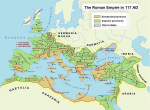
Late Roman Provinces (4th–7th centuries) History Provincial administration reformed and dioceses established by Diocletian, c. 293. Permanent praetorian prefectures established after the death of Constantine I. Empire permanently partitioned after 395. Exarchates of Ravenna and Africa established after 584. After massive territorial losses in the 7th century, the remaining provinces were superseded by the theme system in c. 640–660, although in Asia Minor and parts of Greece they survived under the latter until the early 9th century.Praetorian
Prefecture of GaulDiocese of Gaul: Alpes Poeninae et Graiae • Belgica I • Belgica II • Germania I • Germania II • Lugdunensis I • Lugdunensis II • Lugdunensis III • Lugdunensis IV • Maxima Sequanorum
Diocese of Vienne (later Septem Provinciae): Alpes Maritimae • Aquitanica I • Aquitanica II • Narbonensis I • Narbonensis II • Novempopulania • Viennensis
Diocese of Spain: Baetica • Balearica • Carthaginensis • Gallaecia • Lusitania • Mauretania Tingitana • Tarraconensis
Diocese of Britain: Britannia I • Britannia II • Flavia Caesariensis • Maxima Caesariensis • Valentia (369)Praetorian
Prefecture of ItalyDiocese of Suburbicarian Italy: Apulia et Calabria • Bruttia et Lucania • Campania • Corsica • Picenum Suburbicarium • Samnium • Sardinia • Sicilia • Tuscia et Umbria • Valeria
Diocese of Annonarian Italy: Alpes Cottiae • Flaminia et Picenum Annonarium • Liguria et Aemilia • Raetia I • Raetia II • Venetia et Istria
Diocese of Africa†: Africa proconsularis (Zeugitana) • Byzacena • Mauretania Caesariensis • Mauretania Sitifensis • Numidia Cirtensis • Numidia Militiana • Tripolitania
Diocese of Pannonia (later of Illyricum): Dalmatia • Noricum mediterraneum • Noricum ripense • Pannonia I • Pannonia II • Savia • Valeria ripensisPraetorian
Prefecture of IllyricumPraetorian
Prefecture of the EastDiocese of Thrace: Europa • Haemimontus • Moesia II§ • Rhodope • Scythia§ • Thracia
Diocese of Asia*: Asia • Caria§ • Hellespontus • Insulae§ • Lycaonia (370) • Lycia • Lydia • Pamphylia • Pisidia • Phrygia Pacatiana • Phrygia Salutaria
Diocese of Pontus*: Armenia I* • Armenia II* • Armenia Maior* • Armenian Satrapies* • Armenia III (536) • Armenia IV (536) • Bithynia • Cappadocia I* • Cappadocia II* • Galatia I* • Galatia II Salutaris* • Helenopontus* • Honorias* • Paphlagonia* • Pontus Polemoniacus*
Diocese of the East: Arabia • Cilicia I • Cilicia II • Cyprus§ • Euphratensis • Isauria • Mesopotamia • Osroene • Palaestina I • Palaestina II • Palaestina III Salutaris • Phoenice • Phoenice Libanensis • Syria I • Syria II Salutaris • Theodorias (528)
Diocese of Egypt: Aegyptus I • Aegyptus II • Arcadia • Augustamnica I • Augustamnica II • Libya Superior • Libya Inferior • Thebais Superior • Thebais InferiorOther territories - affected (boundaries modified/abolished/renamed) by Justinian I's administrative reorganization in 534–536 † re-established after reconquest by the Eastern Empire in 534, as the separate prefecture of Africa § joined together into the Quaestura exercitus in 536
Categories:- Former monarchies of Africa
- Former countries in Africa
- States and territories established in 110 BC
- States and territories disestablished in 40
- 40 disestablishments
- Ancient Roman provinces
- Berber history
- History of Mauretania
Wikimedia Foundation. 2010.

